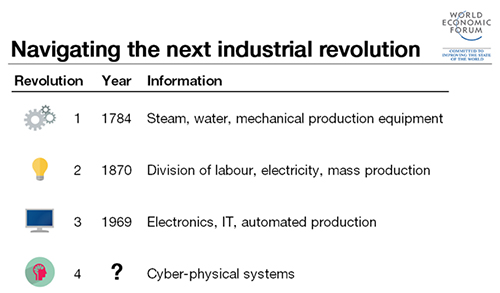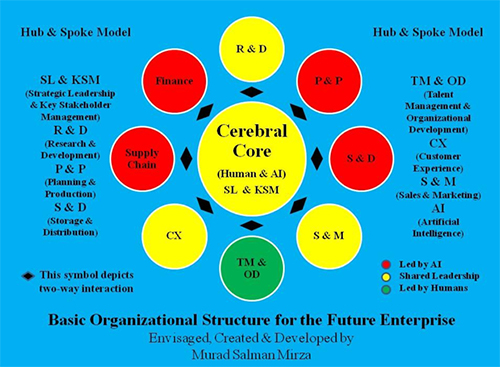AI and the Future Office: Organizing for Tomorrow
By Murad Salman Mirza
History has borne witness to three industrial revolutions and we are now in the throes of the fourth—one which gives rise to a new form of workplace partnership grounded in the technology of artificial intelligence. As per Klaus Schwab’s insights in his article, “The Fourth Industrial Revolution,” what it means and how we might best respond is of increasing importance.

The Face (and Names) of New Industry
The rapid infusion of technology has prompted new expressions of language to capture the extent of the transformation that is reaching into all spheres of human life—such as the Internet of Things (IoT), Augmented Reality (AR), Intelligence Amplification (IA), and, of course, Artificial Intelligence (AI).
All of these technologies are in various stages of development/adaption/adoption in different fields—with AI capturing the limelight supplemented by the strides being made in aligned areas such as neurorobotics, computational neuroscience, computational linguistics, combinational materials Science, cybernetics and 3D printing.
While there is general agreement that the pace of technological innovation and discovery will be remarkable in the coming decades, there are broad differences as to how that might actually impact peoples’ daily lives. Futurists/forward-thinkers/philosophers/strategists are constantly sharing their opinions on what factors will gain prominence in the future; here are seven common questions that guide such prognostications.
- What kind of changes would be there in the future?
- Why will these changes take place?
- How dominant will these changes be?
- Who would be the primary driver of such changes?
- What will these changes look like?
- When will these changes take place?
- Where will these changes take place?
New Models Needed for Human/AI Connection
Despite the boldness of their opinions, few have ventured into presenting a visual context of what the future organization will look like in an era of human/AI partnership. Allow me take this opportunity to present my view of the basic organizational structure of the future enterprise, a publicly traded company that will become the norm in technologically-advanced countries within the 21st century, as follows:

An Organizational Overview of Future Enterprise
I have picked a manufacturing example to convey my perspective; however, it can easily be viewed from a service industry perspective if the manufacturing functions are replaced by services elements. Let’s take a brief look at the key characteristics of the basic organizational structure of the future enterprise.
Organizational Structure to Change Globally
The organizational structure will be no longer be hierarchical; rather, it will gravitate towards a “hub & spoke” model. Most organizations will be global in scope and generally operate with a human workforce of approximately 1,000-5,000. Such a size will be achieved by the huge induction of AI in different functions and massive layoffs of the human workforce. Consequently, current large multinationals, as a survival tactic, will reduce in size and new organizations/startups of the future will eventually reach such a threshold in employees.
Enter the Medium-to-Large-Enterprise
The new size will evolve into a new type of entity that I am naming as a Medium-To-Large Enterprise (MLE). It will possess the primed agility of a medium enterprise and the matured sophistication of a large enterprise. It will be very highly focused on innovation and supremely technology-driven with AI taking a shared and visible role with its human colleagues/peers. Business processes will be optimized at much higher levels than Six Sigma and achieve zero defects. Mergers and acquisitions will become extinct due to the ubiquities nature of technology/expertise/know-how.
Management systems will be seen as sacred, but flexible constitutions, robust enough to sustain market dynamics. Carefully defined core values will cement the corporate foundations and will be actively practiced by both humans and AI. Formal designations will be minimal and will be largely replaced by strategic and operational roles with clearly-defined, relevant skill sets. Understandably, employees will be tech-savvy and multi-skilled with significant cross-functional exposure.
Talent management will significantly tilt in favour of being a science rather than an art. Total Rewards package will be highly attractive. Attrition rates will be negligible. There will be high focus on corporate social responsibility (CSR) initiatives and environmental ownership. Big data use will be prevalent and used extensively in all facets of the organization. The HR function will be split into talent management (TM) and organizational development (OD) with AI having rights as full-time employees through policies/procedures that would cater to their unique requirements.
Cerebral Core
This core will be the main hub of the organization and be operated jointly by both Human and AI colleagues/peers, e.g.:
| Human | AI |
|
|
Other Functions
Shared-leadership functions will follow the pattern of the cerebral core by splitting responsibilities according to relevant skill sets. AI-led functions will have an AI as functional head and will be assisted by a team of AI and human members serving in various assigned roles. Humans will only lead the TM & OD function and will be assisted by human and AI team members according to their relevant skill sets.
Conclusion
The aforementioned reflection of the future enterprise has been presented as a thought-provoking reflection of what can be expected to happen in the years ahead. Technology is evolving at a furious pace buoyed by the comforting proclamation of making lives easier, better, longer and richer.
However, such exuberant promise has to be realized with the sobering prospective downside of a world that is pervaded with AI, e.g., job losses/mass reskilling/shortened careers/early retirements, safety and security of devastated working neighbourhoods, prospects of increased marginalization of less privileged sections of society, rising costs of quality healthcare and education, unabated birthrates, population underutilization, higher percentage of elderly people requiring proper care, etc.
Additionally, there is the little matter of assuming that there will be an amicable partnership between humans and AI without the latter getting any notions/inclinations/compulsions of trying to dominate on account of its superior skills in certain areas with/without the assisted malevolent designs of fellow human beings trying to assert their own intelligence quotients.
The optimist in me says that it will be delightfully complementary; the realist in me winks and says it won’t be that easy, while, the nagging pessimist in me wants to cherish the gift of humanity in the here and now while we can. Let’s see what happens…fingers crossed…
Murad Salman Mirza is an innovative thinker and an astute practitioner of areas within and associated with the fields of Organisational Development, Talent Management and Business Transformation. He has lived, studied and served in different regions of the world, including the US, Australia, South Asia and the Middle East. Murad has more than 15 years of multi-disciplinary experience and has rich exposure to multiple sectors within the corporate world. Currently, he is engaged as a Board Member with two US-based organizations. His LinkedIn profile can be viewed at: Murad Salman Mirza.








